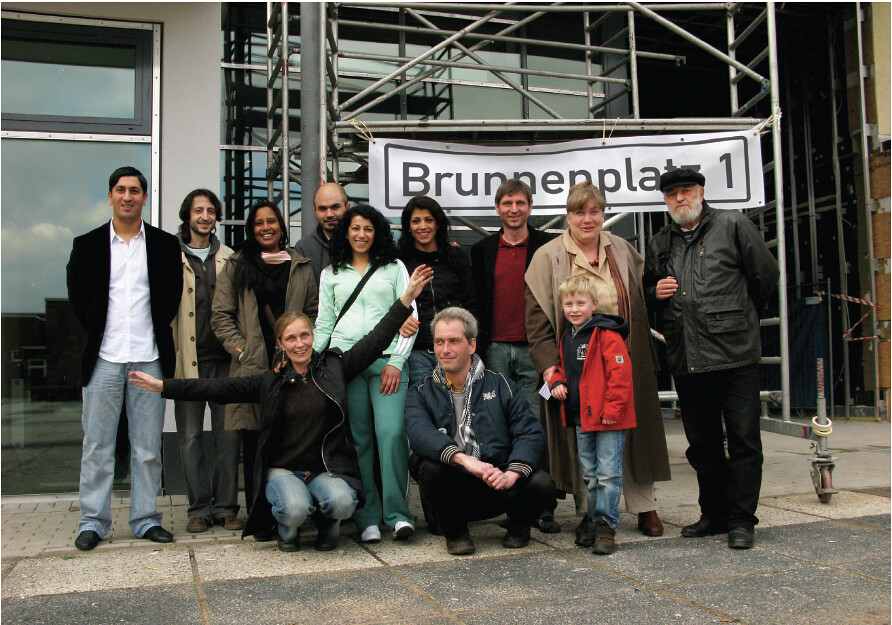
Aktionsteam Action Plan We had regular meetings in my place at Brunnenplatz and everybody was quite enthusiastic about working together with an artist on an art project. The first five people brought together another five and the group became bigger. I will discuss the psychology of this group later but we certainly had our ups and downs. It was a mixed group from the start, however, towards the end of the project only the Germans stayed active. It was also interesting for me that most of them really wanted to formulate themselves in an official way, to become an Association, however, a few other individuals and I were very much against this. We had envisioned this group as an informal group – a network of individuals who joined together for the project and who would help each other and support each other, even though each of them might have a different motivation and the energy to get involved.
Together with Aktionsteam we made a plan for various actions that were carried out by the members of Aktionsteam in June, July and August 2009. The idea of the action programme was to test the limits and understanding of the possibilities within the specific context of this public place – Brunnenplatz . After several meetings and discussions about contemporary art and Hustadt and the city politics we agreed that we would like to create a public place for everybody in Hustadt. It was clear for all of us at the beginning that might be utopian. But anyway why not to try; we would like to make a meeting place with a roof where people could come together even when it was raining. As there was a real need for an assembly space in Hustadt without any political or religious connotation it would make sense to build at least a place with a roof and some extra closed space. We named the building Community Pavilion. (At the time we were already aware that there is no such thing as ONE community in Hustadt, however, by coming under one roof we could all become a community for the moment that we shared). The activities that we planned also functioned as a test for the future Community Pavilion’s possible programme, which should be activated by the people themselves. The idea was to present to the inhabitants a possibility for self-organisation and self-action, and that they could create the conditions for a community based on cultural difference.
The group started to organise a so-called potluck brunch every Sunday in collaboration with IFAK, where usually only immigrants would meet. IFAK is a “Verein fur Multikulturelle Kinder – und Jugendhilfe – Migrationsarbeit / Association for Multicultural Children and Youth Services – Migration work. (/www.ifak-bochum.de/ueber-uns). It is a social organization that has been founded by immigrants themselves since the late 60’. Now we were proposing an event that could function as “everybody coming together”; no doubt it was a bit naïve but it was a try. In the frame of the project Brunnenplatz 1, we started an herb garden, which later on found a place next to the summer kitchen at the Community Pavilion. A bicycle repair workshop has been organised to demonstrate the possibility of creating a self-organised small business opportunity for Hustadt inhabitants. Our programme also included other activities like public storytelling, second-hand book sales, flea markets, handicraft workshops, dance courses, and film screenings. Some actions like gardening, bicycle workshop and the Flea market have continued in 2010 / 2011. Those actions have been the most successful once with the most positive respond from the Hustadt inhabitants
Brunnenplatz doesn’t exist as a post address and therefore has no place on Google Earth, which nowadays means: it doesn’t exist! Therefore we (together with “Aktionsteam”) decided to put a place on the map by creating an address “Brunnenplatz 1” for a new community meeting place. We proposed to the main Housing corporation (VBW) who owns most of the property on the main square to re-address the ground floor spaces which were in the past used for a Public programme into Brunnenplatz 2, Brunnenplatz 3, etc. We wanted to put the heart of Hustadt on the map and no longer pretend that it didn’t exist (as many city politicians have done for the last 40 years!). The VBW accepted our proposal and the project was now in process. I designed the sign Brunnenplatz using the standard official German typeface: Traffic Sign Typefaces: DIN 1451, Mittelschrift which is an official traffic typeface in Germany called DIN 1451 and has a very long history.
No comments:
Post a Comment